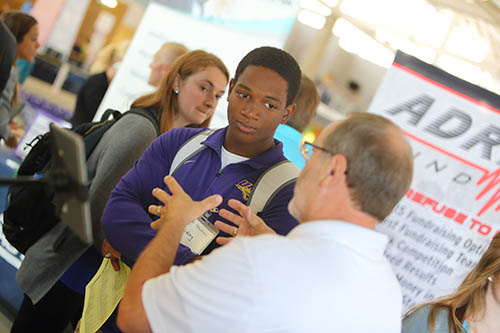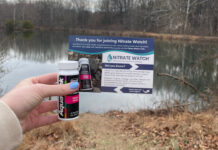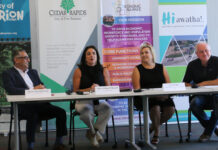
A student listens to a recruiter during a recent career fair at the University of Northern Iowa. Experts emphasize the importance of engagement and transparency for recruitment success.
By Dave DeWitte
[email protected]
In an age when job contacts often originate on the Internet, corporate recruiters are still seeing plenty of action in that tried-and-true recruiting channel: the job fair.
Job or career fairs offer advantages that online recruiting tools usually don’t, including the ability to size up a candidate’s appearance, confidence and verbal skills on the spot. And yet many employers are not making the most of the opportunities these events create.
Part of the problem may be that the market for talent hasn’t been this tight in a long time, and most recruiters weren’t around the last time it was – before the recession of 2008.
“It’s a great time to be a college graduate,” said Matt Nuese, associate director of career services at the University of Northern Iowa. “The employers are really competing again, and they haven’t had that to do that for seven or eight years.”
Mr. Nuese said a good place for employers to start making their job fair presence more effective is in the recruiting team they send. Not every hiring manager or HR staffer feels comfortable stepping up to strangers and asking them about their background and career interests.
“I’d focus on finding that person who’s engaging,” he said.
Morris Pounds, a 31-year veteran career counselor at Kirkwood Community College, said it’s important to bring recruiters who clearly understand the corporate culture and the kind of candidates that succeed in it. He agreed, however, that engaging behaviors – the warm smile, the firm handshake and remembering the jobseeker’s name – are key.
Along with business-appropriate attire, Mr. Pounds said those actions are the same kinds of things he has long advised students to focus on when making a first impression with employer representatives.
“When you’ve visited a lot of career fairs, the ones [employers] that get the traction are the ones with representatives who are interested in the people walking by,” Mr. Pounds said.
It’s not enough for recruiters to sit behind the desk and pass out the occasional recruitment flyer or promotional flash drive. They should be out in front, asking jobseekers what they’re looking for and introducing their company.
“Get out from behind the table and your smart device,” said D. Allan Boettger, senior director of corporate and community outreach at the University of Iowa’s Pomerantz Career Center. He reminds employers that it may be the first time a jobseeker has attended a career fair, so they may be unsure how to interact with representatives.
Mr. Boettger also advises employers to get a jump on the career fair by advertising prior to the event, and sending invitations to students who may already be in their “resume book” to meet with them. He said it doesn’t hurt for employers to double-check their online job postings and career information before the fair to make sure they’re current.
Clearly displaying the type of job positions the employer is recruiting for is a big plus, according to Mr. Pounds. Seeing a job that they are interested in makes the jobseeker more likely to stop by a booth to find out more, he said.
Senior recruiter Mark Hennessey of ACT in Iowa City was out seeking talent for the educational and workplace assessment organization at 11 career fairs last fall. He’s seen job fairs become shorter in duration, more specialized and more efficient in the use of recruiters’ time.
The specialization trend has also increased the importance of adding members to the recruiting team who represent that specialty.
“If it’s veteran-related job fair, we’ll find individuals in the organization who are vets or guard or reserve members,” Mr. Hennessey said. “They can tell a different story than people in HR and recruiting. If it’s a college fair at UNI, we’ll take UNI grads to the event.”
Some career fairs offer onsite interviewing opportunities. If they do, Mr. Hennessey said ACT likes to take advantage of them.
“With the unemployment being so low in this market, if you do find a great candidate you have to strike when the iron is hot,” he noted.
Student shifts
At UNI, the biggest student hiring event is the Fall Career Fair. Mr. Nuese said 200 employers attended the last fall fair, and about 40 of them stuck around for day-after-fair interviews with jobseekers.
“Leave them with a call to action,” Mr. Boettger advises employers. After meeting a good candidate, he says employers should be sure they clearly know the next step, even if it’s just connecting on LinkedIn.
A significant number of UNI student jobseekers like to see diversity represented on an employer’s hiring team, Mr. Nuese said. That goes not just for ethnic or racial diversity, but age diversity, suggesting that employers should consider mixing up the characteristics of their recruiting team members.
The factors that graduating seniors rate highly in considering an employer have been changing at UNI, Mr. Nuese said. Whereas once a graduating senior might have been primarily interested in job fit and starting salary, today, they look at things like career growth potential and cultural fit.
“You’ve heard the saying, ‘I work hard and I play hard’ – they want to see that these people they’ll be spending 50 hours a week with are people they want to be around,” Mr. Nuese said.
Employers can appeal to those changing priorities by emphasizing their strengths. A company that can’t compete with the highest salary might emphasize employee perks like gym memberships or smartphones, Mr. Nuese said. One Cedar Rapids employer likes to emphasize that it brings in a barista to serve espresso drinks on Fridays.
Many career fairs allow employers who pay a premium to get extra-large booths, or prime locations for traffic and visibility.
At Kirkwood, Mr. Pounds said the booths are free to encourage more employer participation. He said some companies even set up a booth without planning any immediate hiring, with the sole intention of getting their name in front of future jobseekers.
The type of display an employer brings to their job fair booth is worthy of consideration but not critical, according to Mr. Pounds. He recommends a display that is bright – not gaudy or overbearing.
Mr. Hennessey, of ACT, concurs.
“Really, what’s going to drive your booth is the people,” he said.




